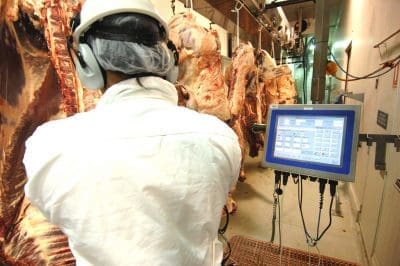QUEENSLAND direct consignment slaughter grid prices continued to come under pressure this week due to supply, with some offers back another 10c/kg on grass export steers and cows.
Other competitors have remained unchanged, suggesting some of this week’s movement may be explained by some ‘catch-up’, after some offers were as much as 20c/kg apart last week as adjustments took place. Other operators have suspended quoting altogether for the timebeing, comfortable that they already have plenty of cattle around them, booking space only.
 Best offers seen for processing in Queensland’s heavily concentrated southern region this morning showed grass four tooth heavy steers with implant 505-510c/kg and 440c/kg on heavy cows.
Best offers seen for processing in Queensland’s heavily concentrated southern region this morning showed grass four tooth heavy steers with implant 505-510c/kg and 440c/kg on heavy cows.
Despite some extra Saturday shifts, additional numbers in regular shifts and other strategies to maximise throughput, there’s some build-up occurring, with one large Queensland operator saying his company is now well-committed through to the second week of July. Others are still pricing for the last week in June.
One company buyer said his company was wary of ‘burnout’ among plant staff being asked to work too many extra Saturday shifts in succession, to keep up with the flow of cattle.
There will inevitably be some delays in reporting on last week’s national beef kill, because of yesterday’s public holiday in most southern states. That impact, once reported, will likely drop the seven-day kill by around 10pc, despite the fact the largest processing state – Queensland – was at work yesterday.
CQ Vs SQ price difference
Further to last week’s discussion around the traditional 10c/kg price difference between processors in Queensland’s southern region, versus areas further north, due to freight cost, several other processors agreed that a larger spread was likely to emerge over time.
“It’s not just the additional freight charges to get the CQ cattle back to process in a plant in southern Queensland,” one operator said. “It’s also the additional cost to get a container of chilled or frozen boxed meat from a CQ or NQ plant to the Port of Brisbane for export. That freight cost is a lot more from a CQ plant than what it is for a processor only a hundred kilometres from the port,” he said.
Another factor was unit cost to process, with northern plants like Mackay and Townsville tending to handle cattle of relatively lighter weight compared with those further south, adding to the per unit processing cost.
In southern states, there have been some substantial price rises in grids in parts of southern NSW this week, with one company lifting rates 40c/kg to around 620c/kg on grass ox and 480c on cows.
Grids from plants in eastern regions of South Australia are relatively cheaper due to adequate supply, around 30-40c behind southern NSW rates this week with one company quoting 550c/kg on grass ox and 520c/kg on cows.
On the sell side, there’s been a moderate rise in lean grinding beef prices into the US last week, after a period of small, but sustained falls. Some big orders from US chain end-users who are not aligned with imported supply out of South America were evident in the market, helping add a floor to prices for lean trimmings, Beef Central was told.
Saleyards trends
With no southern states saleyards operating yesterday due to a public holiday, there are fewer sites to report in early trading this week.
Wodonga sale this morning saw a slight rise in offering numbers to 1620. Heavy steers sold to similar prices to average 326c/kg, while bullock prices improved 8c to average 323c/kg The big offering of cows encouraged buyers to step up for all weights and grades and prices remained strong throughout the sale. Heavy cows were unchanged selling from 266c to 285c/kg. Leaner grades made from 209c to 245c/kg.
Naracoorte this morning yarded only 636 head, although cow numbers actually increased to account for a third of the offering. All the regular buyers operated in a market which stabilised on the dearer rates of last week for good slaughter cows and the limited offering of trade cattle showing some freshness and shape. There was a good lead of heavy cows with weight and fat cover and these consistently sold from 240c to a top of 272c. The average price for the main run of D-muscle cows in fat score 4 condition averaged 266c/kg while the leaner score 3 cows averaged 252c/kg.
Warwick sale in southern Queensland yarded 1246 head this morning, with export lines back 1-9c/kg. Bullocks eased by 9c averaging 268c and selling to 273c/kg. Lightweight cows to processors sold from 139-198c/kg. Light conditioned heavy cows sold from 150c to 198c with good heavy cows at 201c to 225c/kg.

Why do Processors pay 5c/kg less for Heifers than Steers?
What is the rationale for the price variance?
It’s based on meat yield, Wayne. By and large, heifers do not yield as much meat from the same weight carcase as steers, and also tend towards over-fatness. Editor